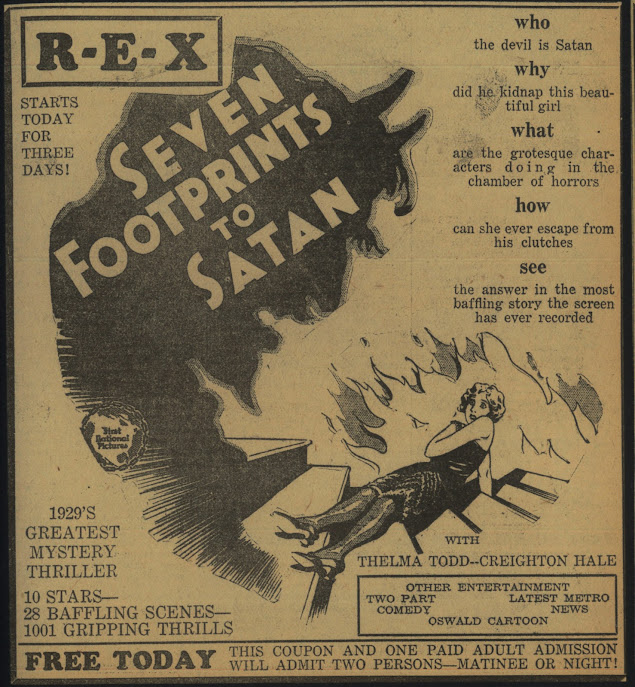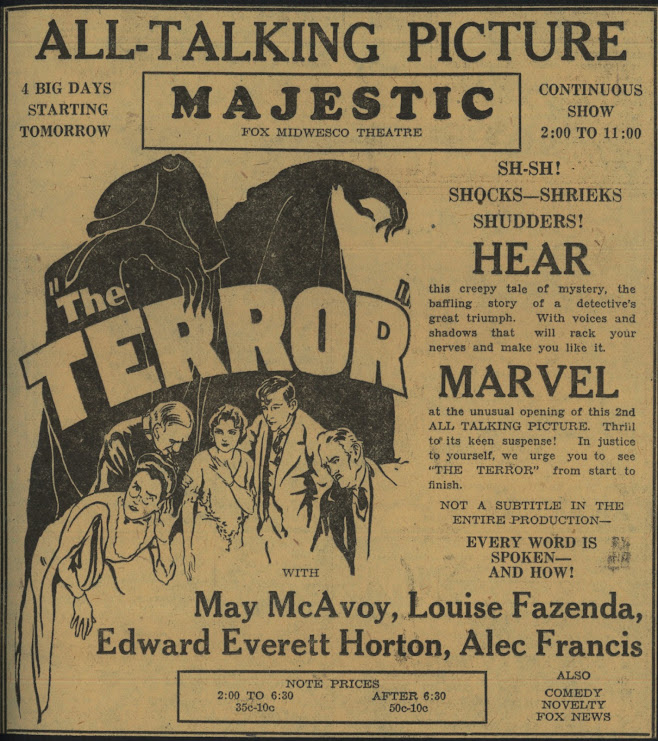Honey of a Horror for Halloween
A 1929 Chiller-Diller Finally Got Right
Been since 1967 a good idea to keep eye out for Seven Footprints to Satan (1929), it showing up in Carlos Clarens’ An Illustrated History of the Horror Film (page at left), a $6.95 book many boys wanted from Santa that year. I got mine, read, and faced reality of not having seen and probably not ever getting to see, most of films “Illustrated” by Mr. Clarens. Seven Footprints to Satan was among these, The Gorilla (1927) and The Terror (1928) tantalizing on a same display. After enough years, you resign to denial of ones vanished long before, Seven Footprints to Satan among then-missing, so how is it a private enterprise called Serial Squadron offered a Blu-Ray for which there was a high-quality You Tube preview? Per such proof that here was the genuine article, I ordered. Squadron has added a score with screams and gunshots to emulate Vitaphone discs of long ago. Rediscovered Seven Footprints to Satan, “re” misapplied as when did any of us “discover” it to begin with? --- gives life to imagery Clarens and other monster mavens dangled via stills and/or blurbs online even a most patient seeker could not endure, me thankful never to have sat for any such clouded transfer, the better to be swept away now by joy that is this Blu-Ray.
Easy to overlook is early-on readers of An Illustrated History of the Horror Film old enough to look back less than forty years at first-runs of what was lost to ones of us younger at the time. Had I been age of now in 1967 and buying this book, all of what Clarens described would be, if not fresh memories, at least still vivid ones, like what it was seeing Jaws or The Godfather: Part Two when new. Imagine if those crumbled to nitrate dust in such interim. Must have been sad not being able to revisit favorites and having but memory and a few stills to know you saw them once and would not again. Movies in that sense were more live performance, equivalent to “I heard Caruso sing … saw Houdini get out of handcuffs … watched Maude Adams as Peter Pan,” varied you-had-to-be-theres-or-forget-its. Seven Footprints wrested out of Satan grip spins imagination toward grails that are A Blind Bargain with Chaney, or dare we suggest, London After Midnight. Had someone suggested a year ago we’d get The (silent) Bat back, let alone The Bat Whispers on wide and crisp Blu-Ray … well, dreams can come true it seems. Accounts I hear of reels by thousands lacking only time and manpower to identify them … but best not light up over that, might as profitably quest for Yetis or unicorns because after all, there are those who claim to have seen them. How was Seven Footprints to Satan sold, perceived by a public coming to it fresh? Ads tell at least a partial story, one here with promise of “28 Baffling Scenes, 1001 Gripping Thrills” (with all that to advantage, how/why did it lose money for WB?). Having now seen Seven Footprints to Satan, I would sign affidavit to effect that there really are 28 baffling scenes, likely more. It’s fun to be frightened!, bally and barkers used to say, fun the key because who sought to be truly scared by films where living dealt scares enough? Always seemed to me monsters should be arresting, not revolting, side trip I’ll not take today. Enough to say that seeing The Cat and the Canary, or any of the Bats, should prepare you for quasi-chilling and comedy that is reality of Seven Footprints to Satan, so no complaint please over “cop-out” or letdown at its ending. Them was the rules then, and they were inviolate.
Comedy as relief was essential to what was determinably light amusement. No one was for leaving theatres unstrung or depressed. Enough of what waited for them outside saw to that. Seven Footprints to Satan, in its final outcome especially, was ideal fulfillment of what makers and their audience desired from a “mystery thriller.” Our expectations having changed over a succeeding century does not make us right and them wrong. We get pleasure in what they thought would “thrill,” as yes it does satisfy to see devices untried since silents and grotesqueries foreclosed for one reason or other from modern films. Less explicable is supernatural events always rationally explained at that time, as if maintaining Code of its own that no ghosts shall walk among us. Was industry being “responsible” in the face of spiritualism and belief in back-from-dead gripping multitudes after a first World War? Too many it seems were talking to departeds via false mediums, charlatans of all stripes. Famed proponent Arthur Conan Doyle was put under microscope of is he right, or what? I’ve not seen above feature asking that question (see lobby card), film which we assume is missing, but would figure it no way supported Doyle’s notion that the dead could come back and talk with us. Motion pictures as sensible outreach assured such things had no basis in reality. I’m trying to think of a full-on silent spook story and can not so far come up with one, but what if there were several among so-called “lost” features? Are always rational explanations what it took to keep a twenties viewership calm? Difficult to know how vulnerable folks in the twenties would have been to latter-day horror assaults, us not better off now for being numb to them. Seven Footprints to Satan is like Grand Touring a haunted house as conceived by long past era that may itself have been a little haunted. '29 photos and film can convince us so, but then there are those who’d say circumstance of a mere decade ago might have a same unsettling effect on us. Each generation seeks their own level of fear, or level of same they go to for recreation.
Do current haunted houses dwell on dwarves, gorillas, “dog men,” Asian agents of harm? Based on '29 Footprints, I'd say not. Apes loosed seem archaic to us unless they carry a chain saw. Footprints is keyed to thrills outlandish enough to indicate an all-in-fun finish. To be surprised or let down by same is to not know conventions in place when Seven Footprints to Satan was new. 2024 is so determined for chillers to terrify as to be almost unreasonable about it. What if early filmmakers had served them our way? They sort of did with Freaks and Island of Lost Souls and look what happened to those. Seven Footprints to Satan was OK for children to enjoy, and I’ll guess they were sophisticated enough in 1929 for Mom-Dad not to have to explain that it’s all a frolic so don’t get skittish. Too bad Ackerman, Bradbury, other first-run veterans, aren’t around to tell specific what those experiences were like (plenty of anecdotal evidence re Phantom of the Opera, but what of obscure others?). Fact is I'm just guessing at how Foot falls fell. Old Famous Monsters magazines are spotted with imagery and comment about Seven Footprints to Satan, the title thus presence in my life from early on, one of reasons it satisfies to finally see the feature. Director was Benjamin Christensen, who we’d know better if more of his films survived, Christensen rather like Paul Leni, whose films do survive, even if Paul himself did not. Christensen’s House of Horror and The Haunted House, coming before or just after release of Footprints, are gone as footprints on Egyptian sand. We get sense of fun in Satan’s making from cast-crew captures here, appeal-crossing-all-genres Thelma Todd as lead with Creighton Hale, latter not dissimilar from who he was in Cat/Canary, if less simpy and ineffectual. There are favorites Angelo Rossitto and Sojin plus Sheldon Lewis who had done creepy serials and was a Jekyll-Hyde before Barrymore, also Charles Gemora in ape skin. It was Italians and the Danish who preserved Seven Footprints to Satan, prints for years ragged and with foreign subtitles. I much enjoyed Squadron’s presentation. If Halloween has a highlight for 2024, Seven Footprints to Satan is it for me.

































